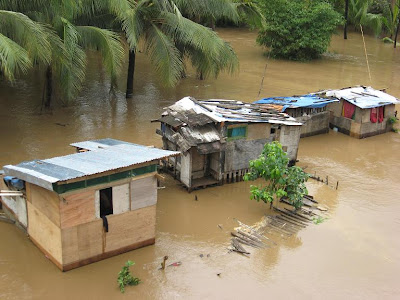 A local eco-system long ignored and grossly violated reacted quickly and without notice. Unleashing flashfloods fueled by torrential rains, and as some feared coupled with the deadly effects of a waterspout crashing into denuded mountainous areas close to the city.
A local eco-system long ignored and grossly violated reacted quickly and without notice. Unleashing flashfloods fueled by torrential rains, and as some feared coupled with the deadly effects of a waterspout crashing into denuded mountainous areas close to the city.The usually lazy river traversing through the city becomes a roaring and rushing blur of dirty brown water, curdling and ripping through everything standing on its way and angrily catapulting flailing catches into the sea.
 And the hapless human victims are those who live close to its banks, including those squatting on government lands technically part of the riverbanks. And worse for those who had allocated for themselves the underside of bridges and anywhere close to them that provided shelter and privacy. These areas for the meantime are no more, but merely annexed parts of an overgrown river.
And the hapless human victims are those who live close to its banks, including those squatting on government lands technically part of the riverbanks. And worse for those who had allocated for themselves the underside of bridges and anywhere close to them that provided shelter and privacy. These areas for the meantime are no more, but merely annexed parts of an overgrown river.The rustic scenes pictorialized in a previous blog entry have turned watery and ugly, with the makeshift structures mostly underwater and their occupants scampering to higher ground with their meager belongings on their backs.
After revisiting the same areas, here are the results of the flooding and the devastation wrought as seen in pictures.











I don't know about rustic. I think I'd go with shabby or trashy. I saw rustic on White Island, a little islet just off Camiguin, where the locals had built their kubos 10 feet up on coconut logs with thatched roofs for protection from the sun and rain. There wasn't a bit of castoff siding or rusty old roofing in sight. Now THAT was rustic.
ReplyDeleteSorry to quibble.
They must not have the same weather down there as up here. We are in the middle of the dry season now and probably won't see a speck of rain for two or three months more.
Phil:
ReplyDeleteBut you are right, the truly rustic scene would have been a nipa hut, with thatched roof and bamboo poles and walls. And I can recall my frugal grandmother living on one such abode in Cebu.
Anyway, there wasn't even a typhoon warning this time. Just a so-so climate suddenly turning ugly. I go for the waterspout explanation. It has happened many times before hereabouts. The appearance of suddenly abundant water quickly making its own paths to the sea. Then just as suddenly, it is completely gone and back to dry season.
The locals call this buhawi.
Interesting. Must be something that happens near the sea, as you are. Must have been a hell of a water spout to dump THAT much water though. Ever see any sea fish stranded on land from such a thing? That would be the certain evidence of it.
ReplyDeleteGood question about the sea fish. And I have no answer, though I have been in the middle of one huge waterspout at least once.
ReplyDeleteThough I have seen cows and carabaos flailing about in the floodwaters.
BTW, many local fishes here actually thrive on brackish and sea waters. The bangus is one such kind. Thus finding them in floodwaters would not be conclusive.
Maybe finding a shark or dolphin in the rivers?
There are different types of waterspouts, as you probably know; the ones in the tropics are generally weaker than the ones in Florida and thereabouts. What I'm talking about are fish, usually small ones, that get sucked up into the tornado-like spout and subsequently dumped over land. You've heard the stories right, where people have been rained on by schools of fish? That would be something to see.
ReplyDeleteA sight to see indeed - raining fishes!
ReplyDeleteBut no such reports hereabouts that I know of.